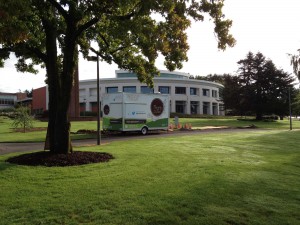Culinary Arts Taskforce recommends dramatic overhaul of program

Arriving in late August, The Mighty Bowl was the first food cart to move onto campus, opening September 13.
This past fall, the Culinary Arts Taskforce was formed to work on two things: revamping the Culinary Arts, Food program and improving food-service options on the main campus. Recently the Taskforce released its findings, and they could indicate dramatic changes not just in the program and the college’s dining options, but in the look and shape of the campus as well.
The Taskforce quickly recognized one major challenge facing the current Culinary Arts program: In order to stay up-to-date with modern culinary trends, students needed instructional time to develop skills and learn about new tools and technology, theories, dietary restrictions, and global cuisine. However, the program was also responsible for most of the food production at the college, which left little time for purely instructional lab activities and skill development.
At the same time, because Culinary Arts students were responsible for producing most of the food at campus, food service was limited to their class hours—and both students and employees often need to eat at times outside those hours.
Looking at these challenges, it became clear to the Taskforce that the Culinary Arts program needed to stop being the sole source of food on campus. The solution: Bring in local vendors, in a limited capacity, to augment food service for the campus community. Meanwhile, Culinary Arts students would take part in more-rigorous academics and updated lab activities—while still gaining hands-on experience by providing some food service to the college. The program would also move to a cohort model and be designed to qualify for accreditation by the American Culinary Federation.
In order to accomplish all this, however, something else needed to change: the facility itself. Students would need access to SMART classrooms and a demonstration kitchen (currently the program has neither) to learn the new curriculum, and outside vendors would want a larger, more inviting space in which to set up shop. So the Taskforce also recommended adding a second story to the northwest corner of Gaiser Hall and remodeling the first-floor section to house a modern food court with different cook-to-order kiosks, a new bakery area, and a modern dining room. The second floor would include the SMART classrooms, offices, and other facilities required for a modern Culinary Arts program.
“[A] renovation, while costly, is an investment in the program, an investment in student retention, and an investment in the goals of the Strategic Plan,” the Taskforce’s final proposal concludes. “The creation of an inviting space for students, faculty, and staff to congregate as members of a community will serve Clark College for decades to come.”
The next step will be a predesign study to accurately budget for these renovations—after that, the fundraising process to make these proposals reality can begin. Meanwhile, the Culinary Arts, Food program is not taking new students. Learn more about the proposed changes online at http://www.clark.edu/academics/programs/culinary_arts/Taskforce_Proposal.pdf.
Meet Your (Lunch) Makers
So where will students and employees eat while the Culinary Arts, Food program goes through its transformation? In addition to currently existing food kiosks around campus and the Bakery (which will continue service during the revamp), three new food carts will set up shop on the walkway on the east side of Gaiser Hall. Here they are, with links to their websites and expected beginning month of service:
Photo: Clark College/Hannah Erickson












